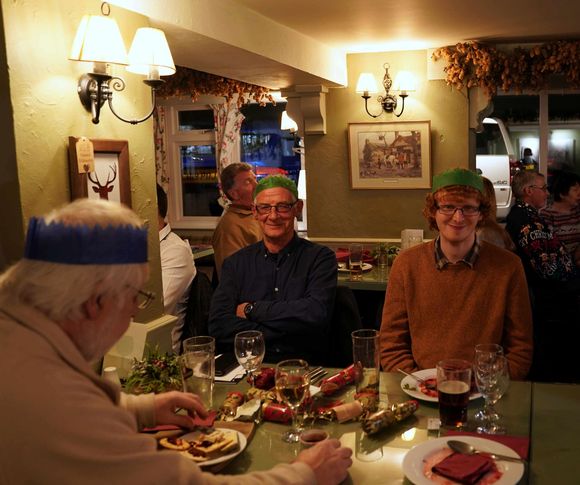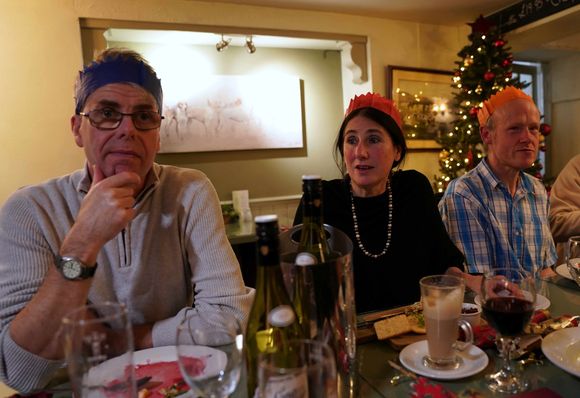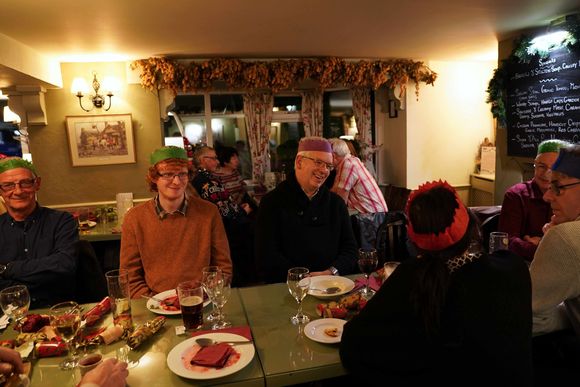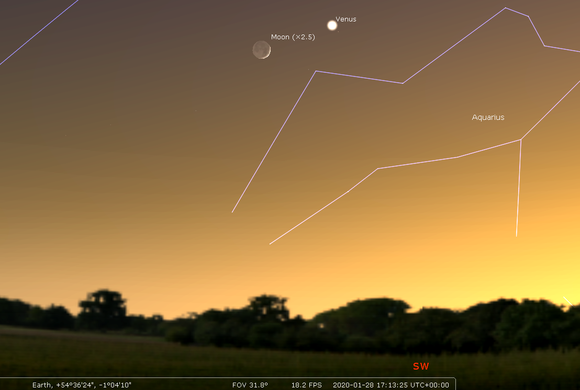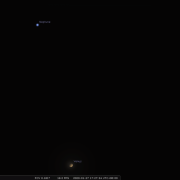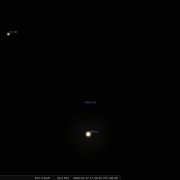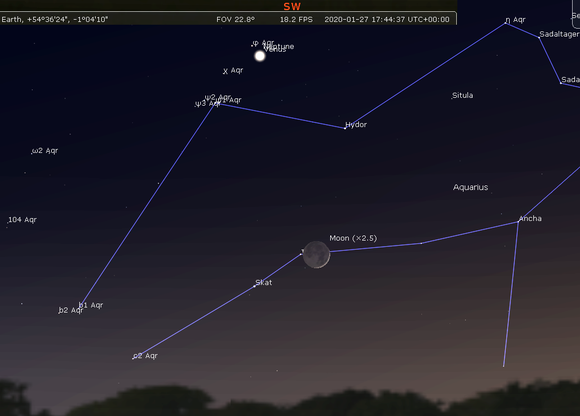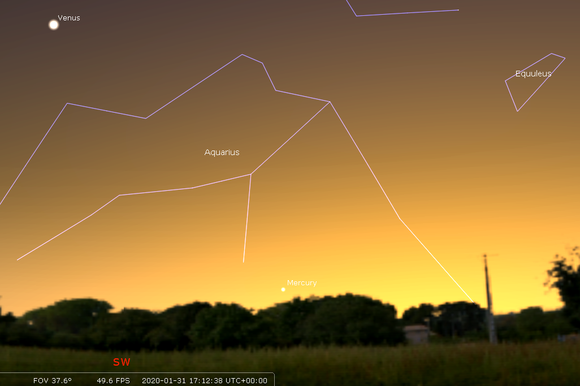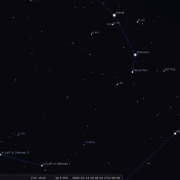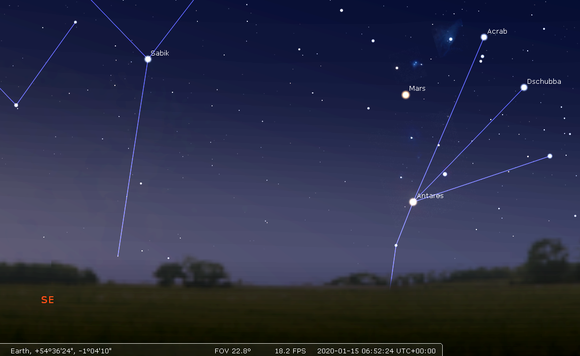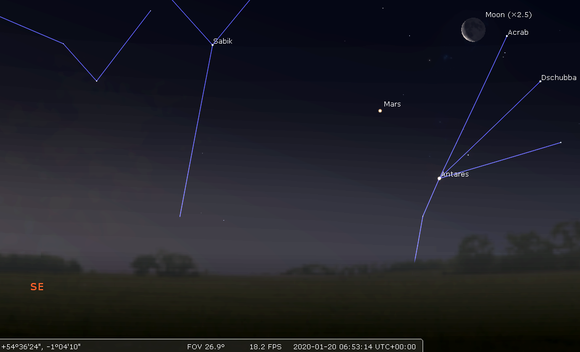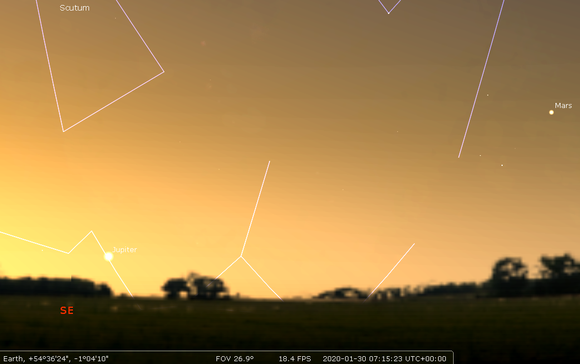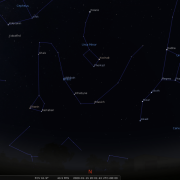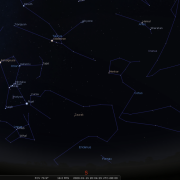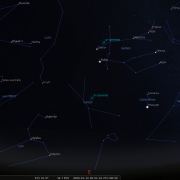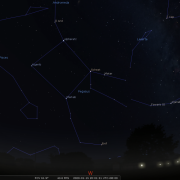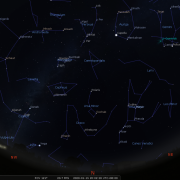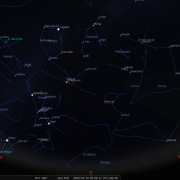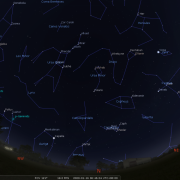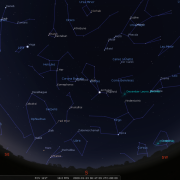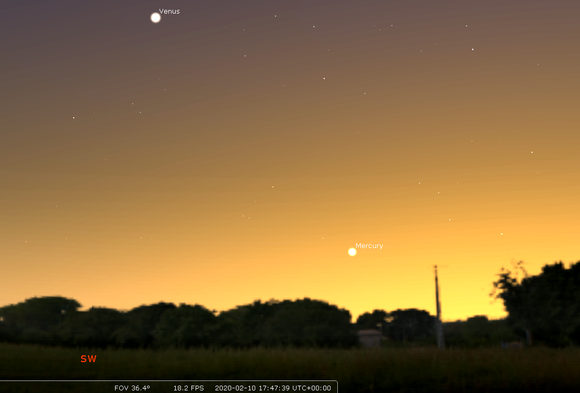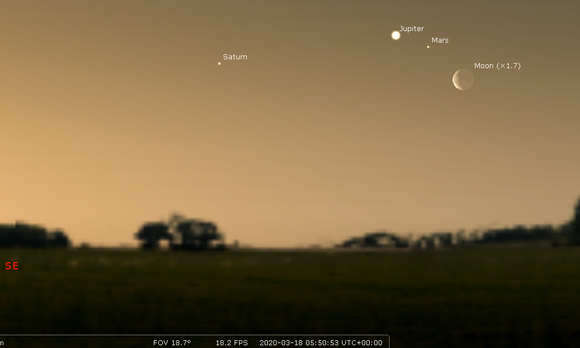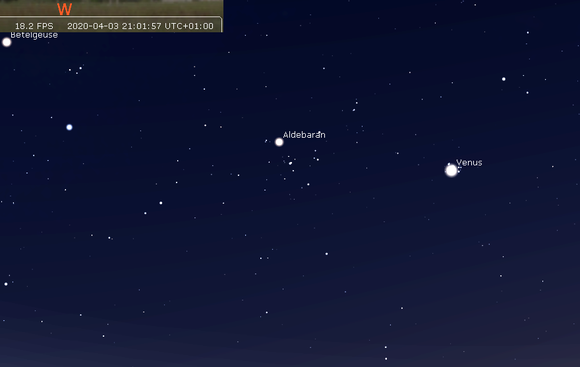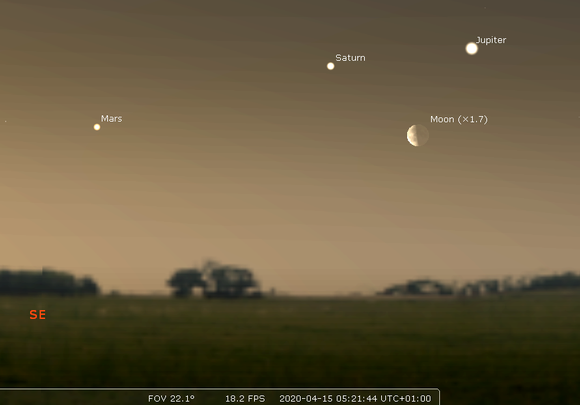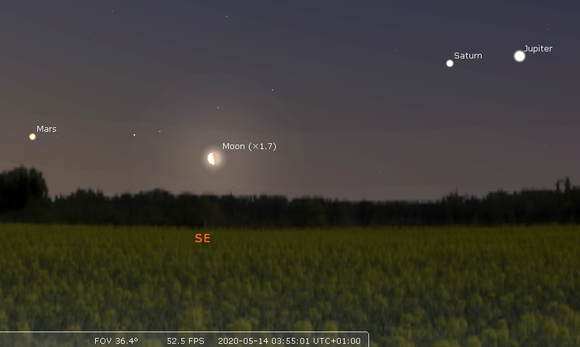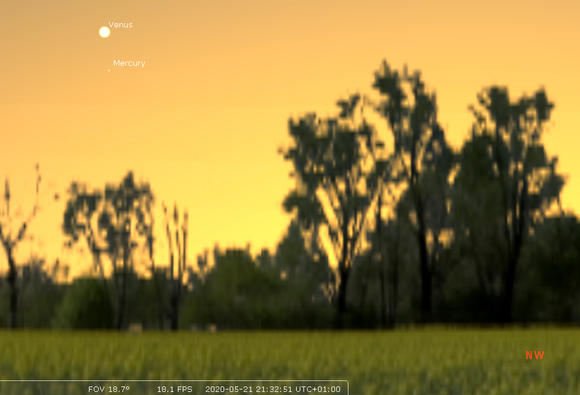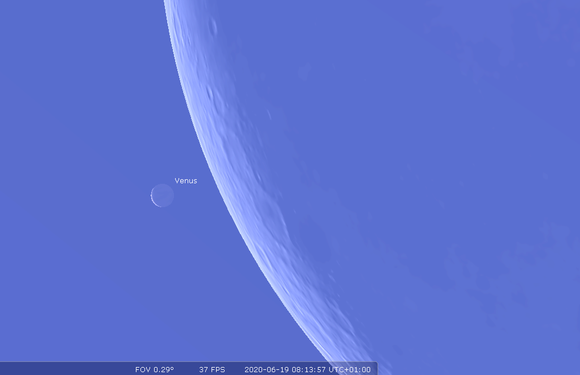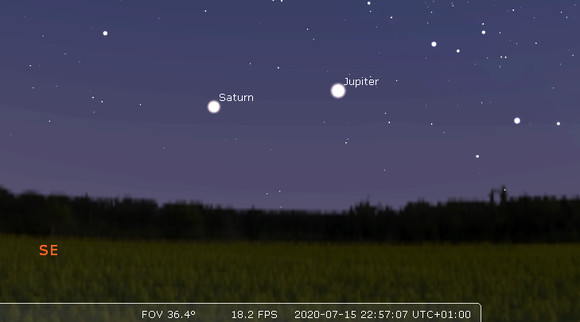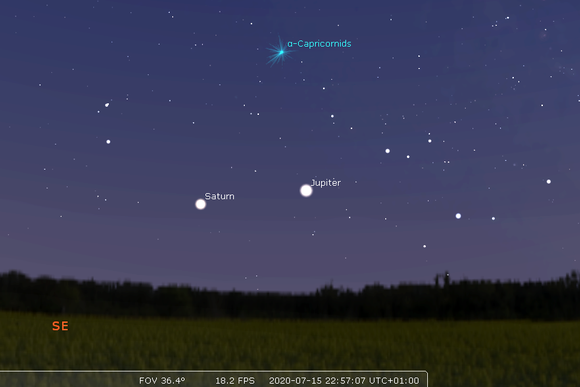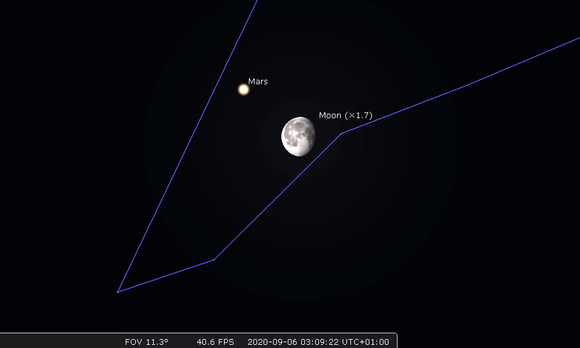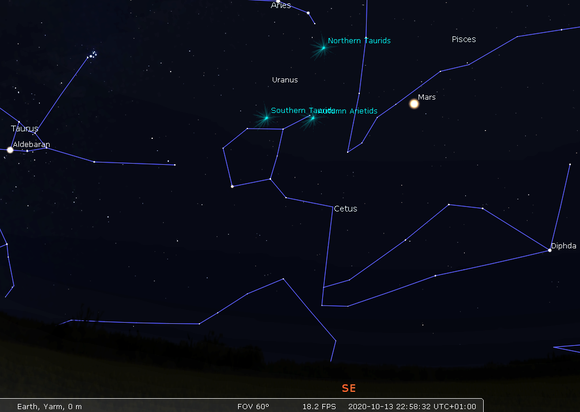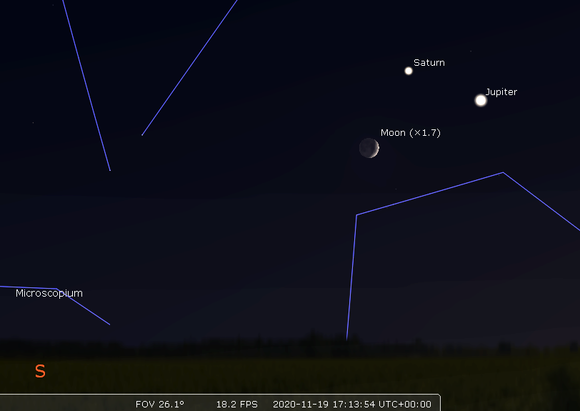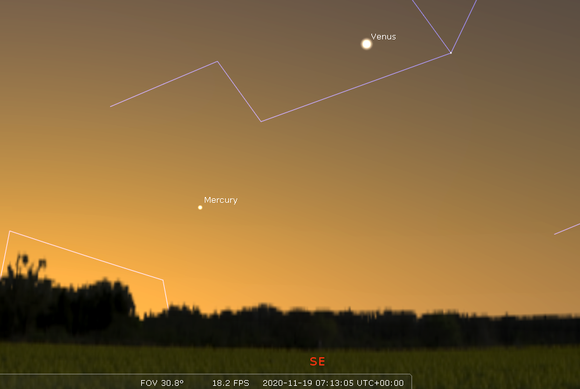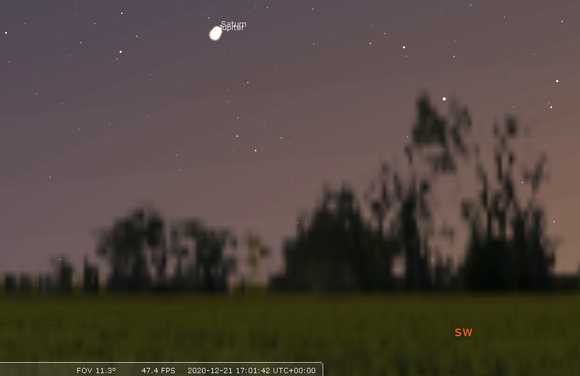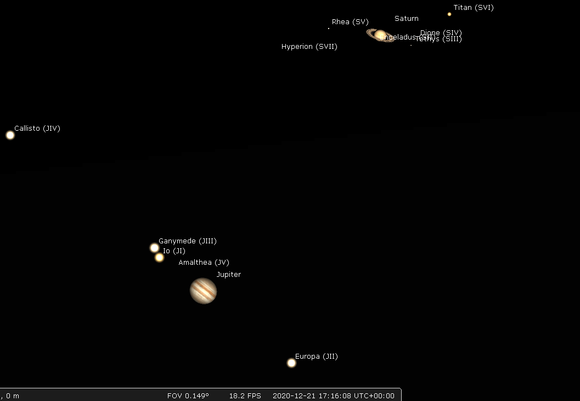Welcome to the WDAS monthly newsletter for January 2020: a digest of the month's latest contributions to our website, and a Happy New Year to all our Members. Below you'll find Society News: including the photos from the Christmas Meal where Andy Lawrence was recorded for the first time (?) not partaking of the Cheeseboard. In Sky Notes there's mention of Earth at Perihelion and an unexciting penumbral eclipse of the Moon. And a highlight of this month is a look ahead to see what Sky treats are in store throughout 2020.
Society News
Hardly seems like twelve months have slipped by, but once again society members found themselves in the Hare and Hounds, passing out Christmas cards, pulling crackers, donning paper hats, pondering the nature of the plastic toys inside, groaning at the terrible Christmas jokes, but most of all looking forward to the Christmas fayre.
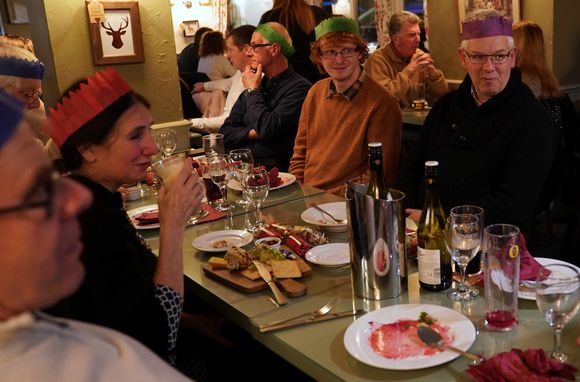 Andy tells a story; Barbara, two Marks and Lee nod; meanwhile pepper pot hides behind menu. And where's Andi? (Come-on guys, you know the routine... click for full image!)
Andy tells a story; Barbara, two Marks and Lee nod; meanwhile pepper pot hides behind menu. And where's Andi? (Come-on guys, you know the routine... click for full image!)
December 14th was also peak of the Geminid meteor shower, but that had occurred during the early morning hours and none were noticed that evening during a short and impromptu observing session from the Hare and Hounds car park. Nine members eventually made it along for the evening, Andy L, Mark and Barbara, Keith, John L, Lee, Victor, Mark and Saul.
The evening was most enjoyable, the usual mix of debate, discussion, plus the eating and drinking of course; 3 of those: starters, main and dessert! The food was pretty much polished off. There were no menu issues either, so Mark had correctly placed the orders. After settling up the bill, by 22:00h members made their way home, most satisfied. Pics will be available on the website. Here’s to next year’s event.
And with one last photo, wishing you a Happy New Year...
We shall be having a busy little period at the end of February with society involvement in several star party events.
On the 21st we shall be returning to the Fox and Hounds – Ainthorpe for their organised ‘Star Night’. The following evening we shall be along the road at The Danby Moors Centre for part two and their ‘Dark sky’ public star party event on the 22nd (from 19:00h) Then on Friday 28th we shall be down at Fylinghall School for their Dark Sky event, again from 19:00h.
Full details will be given in the February notes, however at this juncture, just make a note in your diary and if you can make it along (with a telescope) it would be mighty helpful.
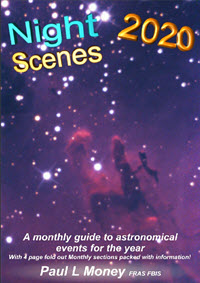 As of publishing we are still awaiting Night Scenes 2020, but they should be with us soon. We have ordered 25 copies and if you want to reserve a copy please contact Mark.
As of publishing we are still awaiting Night Scenes 2020, but they should be with us soon. We have ordered 25 copies and if you want to reserve a copy please contact Mark.
Stop Press: Night-Scenes have left the Printers! Hopefuly they will reach us in time for the WDAS December meeting. If not we will inform you when they do.
Reluctantly the price of Night Scenes has had to be increased slightly, but even at £5 (for Members) it still represents outstanding value.
Sky Notes
In this month's Sky Notes:
- Planetary Skylights
- Meteors
- Penumbral Lunar Eclipse
- Earth reaches Perihelion
- January 2020 Sky Charts
Planetary Skylights
The New Year commences with just two naked eye planets visible, Venus in the evening twilight sky and Mars in the dawn sky.
 Venus is gradually drawing away from the SW horizon growing in presence as it does so and dominating the early evening sky. Through a telescope Venus exhibits a phase, which throughout January will be a waning gibbous. Other than that there is little to see, the now permanent duvet of cloud blanketing the planet, hiding the surface from scrutiny.
Venus is gradually drawing away from the SW horizon growing in presence as it does so and dominating the early evening sky. Through a telescope Venus exhibits a phase, which throughout January will be a waning gibbous. Other than that there is little to see, the now permanent duvet of cloud blanketing the planet, hiding the surface from scrutiny.

 If conditions are clear on the 27th, aim your telescope (low/medium power) towards Venus around 05:50-18:00h and you will also spot the outer planet Neptune, a tiny blue grey disk visible close by. The crescent Moon blunders onto the scene the following evening; the 28th.
If conditions are clear on the 27th, aim your telescope (low/medium power) towards Venus around 05:50-18:00h and you will also spot the outer planet Neptune, a tiny blue grey disk visible close by. The crescent Moon blunders onto the scene the following evening; the 28th.
 Mercury commences its best evening apparition of 2020 at the very end of January; however most of the apparition will occur during February, so we shall leave it until then.
Mercury commences its best evening apparition of 2020 at the very end of January; however most of the apparition will occur during February, so we shall leave it until then.
 Uranus resides in Aries, well placed high to the south during the evening. Although technically visible to the naked eye at Mag. +5.9, in reality binoculars, or better still, a telescope are required to spot it. Uranus resides just within the borders of Aries quite some distance below the ‘crooked line’ asterism of the Ram. If you have a constellation chart or App etc, use Mesarthim and iota Aries as pointers to locate Uranus, which resides 3 times the distance between these stars and a tad to the right, below them. Through a telescope Uranus resembles a very small disk of subtle grey/green hue.
Uranus resides in Aries, well placed high to the south during the evening. Although technically visible to the naked eye at Mag. +5.9, in reality binoculars, or better still, a telescope are required to spot it. Uranus resides just within the borders of Aries quite some distance below the ‘crooked line’ asterism of the Ram. If you have a constellation chart or App etc, use Mesarthim and iota Aries as pointers to locate Uranus, which resides 3 times the distance between these stars and a tad to the right, below them. Through a telescope Uranus resembles a very small disk of subtle grey/green hue.
 Mars is the solitary naked planet in the dawn sky moving quite rapidly against the backdrop of three constellations over the course of January: - Libra, Scorpius and Ophuichus. Look for it in the SSE around 07:15h not too far above the horizon. Currently not a brilliant object, Mars resembles a first magnitude amber hued star. Do not however mistake it for Antares, chief star in Scorpius, which is also orange in hue and above which Mars resides around midmonth. The Moon lies close to Mars on the 21st.
Mars is the solitary naked planet in the dawn sky moving quite rapidly against the backdrop of three constellations over the course of January: - Libra, Scorpius and Ophuichus. Look for it in the SSE around 07:15h not too far above the horizon. Currently not a brilliant object, Mars resembles a first magnitude amber hued star. Do not however mistake it for Antares, chief star in Scorpius, which is also orange in hue and above which Mars resides around midmonth. The Moon lies close to Mars on the 21st.
15-Jan-2020 at 07:00h (SE): Mars and Antares. (Click for full-sized image)
20-Jan-2019 at 07:00h (SE): The Moon, Mars and Antares. (Click for full-sized image)
 At the very end of the month Jupiter returns to the morning sky, but will be a difficult object to spot very low down above the ESE horizon around 30 minutes before sunrise. It has a long observing road ahead and there will be ample opportunity to view it throughout 2020.
At the very end of the month Jupiter returns to the morning sky, but will be a difficult object to spot very low down above the ESE horizon around 30 minutes before sunrise. It has a long observing road ahead and there will be ample opportunity to view it throughout 2020.
Meteors

One of the more prolific annual meteor showers is active during the first week in January, the Quadrantids (Jan1st-6th) peaking over the night of the 3/4th.
The Moon is at first quarter on the evening of the 3rd, so ideally if you can wait until after midnight – into the early morning hours of the 4th the moon will have set by then. The peak can sometimes yield in excess of 100 meteors per hour and with the radiant of this now defunct constellation located high up (circumpolar) to the north, observed numbers of shooting stars could be as high as 50 per hour.
The Quadrantids appear to radiate from the now defunct constellation of Quadrans Muralis, which was removed from sky charts in 1922, but used to lie at the junction between Hercules, Bootes and Ursa Major. This position in the sky is located low to the North at the time of the peak, so do not concentrate on this aspect when viewing.
If conditions are clear, wrap up warm, prepare a flask and enjoy!
Lunar Eclipse
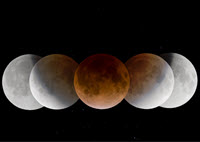
Preumbral Lunar Eclipse
(Image: Ad Astra La Palma)
There is a penumbral eclipse of the Full Moon on the 10th, however don’t get too excited as only some very slight dimming of the moon will be noticeable during the evening. Not one for the scrap books really!
Earth reaches Perihelion
Finally, on Jan 3rd Earth reaches Perihelion (closest to the Sun in its orbit) some 91.4 million miles or 147 million km distant. This usually comes as a surprise to non astronomers, who expect the Earth to be furthest from the Sun in January. As we know it’s not the distance from the Sun, which gives rise to the short, dark winter days, but the tilt of the Earth’s axis, with the northern hemisphere being tilted away.
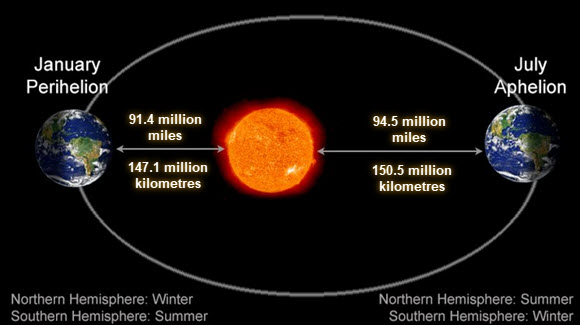
January 2020 Sky Charts
|
Looking North
Mid-January - 20:00h |
Looking South |
|
Looking East
Mid-January - 20:00h |
Looking West
Mid-January - 20:00h |
|
Northern Aspect
Mid-January - 20:00h |
Southern Aspect
Mid-January - 20:00h |
|
Looking North (Early)
Mid-January - 06:45h |
Looking South (Early)
Mid-January - 06:45h |
Additional Image Credits:
- Planets and Comets where not otherwise mentioned: NASA
- Sky Charts: Stellarium Software
February
Mercury has a fine evening apparition during February – the best of the year, Whilst Venus continues to climb higher into and dominate the evening sky. Saturn returns to the morning sky, joining Jupiter and Mars.
(For all the images below, click to see the full-sized image.)
March
March sees Venus continuing to dominate the evening sky and is in conjunction with Uranus on the 8/9th, whilst in the dawn sky, Mars is really motoring, passing below both Jupiter and Saturn over the course of the month
April
Venus encounters the Pleiades in early April, blundering right through the seven sisters. Mars, Jupiter and Saturn continue to hold court in the dawn sky and the Lyrid meteors are favourable on the 22nd.
May
During May, Venus drops back toward the SW horizon passing Mercury as it arcs up and round during the latter part of the month. The early dawn sky continues to play host to Mars, Jupiter and Saturn, although the red planet has by now put some distance between it and the gas giants.
June
Mercury is viewable for the first week of June after sunset, so it’s the very late evening and early morning hours which provide much of the planetary interest, hosting Mars, Jupiter and Saturn. However, perhaps the highlight of the month is the occultation of Venus by the Moon in broad daylight. Care and scrutiny will be required for this event.
July
Both Jupiter and Saturn come to opposition in July and will be visible low in the sky from sunset to sunrise. The two planets are relatively close together in the sky and continue to draw together in the coming months. Mars is visible in the early morning sky in the SE, whilst Mercury and Venus lie round in the ENE. The moon occults the deep sky object M1 – the Crab nebula on the 18th around 03:30h.
August
Jupiter and Saturn dominate the August evening sky Whilst, Venus dominates the early mornings. Mars is finally growing brighter and larger in the eyepiece. The Perseid meteor shower is best observed during the evening of the 12th, the moon interfering with observations post midnight. The minor planet Vesta careers through the open cluster M44 (the Beehive in Cancer at the end of the month.
September
September, and the Jupiter and Saturn combo continues to draw the eye during the early part of evening, well placed low to the south as twilight falls. Their dominance is however challenged by Mars which brightens considerably throughout the month; becoming a brilliant orange beacon located in the ESE. Distant Neptune reaches opposition, located near phi Aquarius. Venus reigns supreme in the dawn sky.
October
October: Jupiter and Saturn continue to edge closer together, but the highlight is the opposition of Mars around mid month, the red planet now being the dominant object in the night sky. Venus dominates the early morning sky and lies very close to Regulus in Leo on the 3rd. Both the Draconid and Orion meteor showers are favourable, not compromised by moon light. Uranus comes to opposition at the end of the month.
November
Throughout November Jupiter and Saturn continue to close, residing low in the SW during the early evening. Mars dominates the evening sky to the south, whilst Venus dominates the morning sky and is joined by Mercury from mid month. The Leonid meteor shower is favourable over the night of the 17/18th.
December
December, and the year ends with a spectacular planetary conjunction involving Jupiter and Saturn separated by just 6 arc minutes on the 21st. The pair will be sliding down into the SW evening twilight, appearing almost as one object to the naked eye. Mars continues to be a prominent object to the south. Venus is likewise in the morning sky, but dropping back to the horizon. Finally both the Geminid and Ursid meteor showers will be favourable.
There may be no worthwhile eclipses visible from the UK or any predicted naked eye comets, this year, but the planetary action in 2020 certainly makes up for the lack of these.
Events
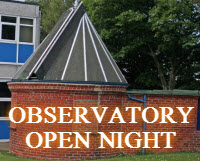 Observe the night sky with us at the Bruce Observatory, Whitby School
Observe the night sky with us at the Bruce Observatory, Whitby School
Observing Nights are held weather permitting: check for a relatively clear sky before leaving home. If in doubt, Mark can be reached on 07886069339
Please note the college drive gate is now operated via a electronic key code - so anyone wishing to attend must be at the car park at the top of the drive by 19:00hrs - unless an arrival time has been arranged with Mark/Keith.
 Observe the night sky with us at the Bruce Observatory, Whitby School
Observe the night sky with us at the Bruce Observatory, Whitby School
Observing Nights are held weather permitting: check for a relatively clear sky before leaving home. If in doubt, Mark can be reached on 07886069339
Please note the college drive gate is now operated via a electronic key code - so anyone wishing to attend must be at the car park at the top of the drive by 19:00hrs - unless an arrival time has been arranged with Mark/Keith.
 Whitby School - Room H1.
Whitby School - Room H1.
In Members' monthly meetings we usually take a tour of the night sky for the coming month using the Planetarium program. Have talks and presentations on various topics of astronomy/space etc, and discuss future events etc. New members welcome.
 Observe the night sky with us at the Bruce Observatory, Whitby School
Observe the night sky with us at the Bruce Observatory, Whitby School
Observing Nights are held weather permitting: check for a relatively clear sky before leaving home. If in doubt, Mark can be reached on 07886069339
Please note the college drive gate is now operated via a electronic key code - so anyone wishing to attend must be at the car park at the top of the drive by 19:00hrs - unless an arrival time has been arranged with Mark/Keith.
 Observe the night sky with us at the Bruce Observatory, Whitby School
Observe the night sky with us at the Bruce Observatory, Whitby School
Observing Nights are held weather permitting: check for a relatively clear sky before leaving home. If in doubt, Mark can be reached on 07886069339
Please note the college drive gate is now operated via a electronic key code - so anyone wishing to attend must be at the car park at the top of the drive by 19:00hrs - unless an arrival time has been arranged with Mark/Keith.


